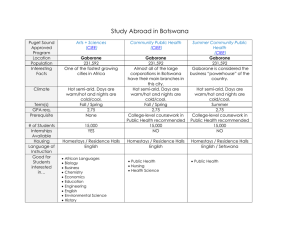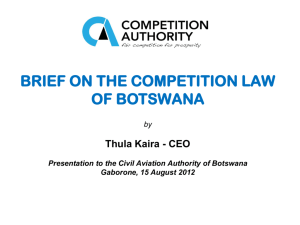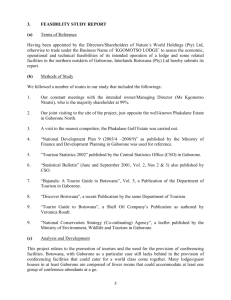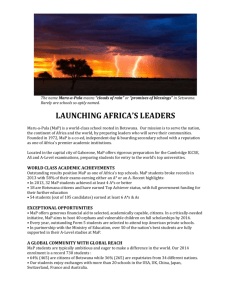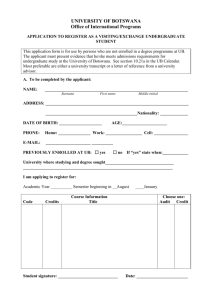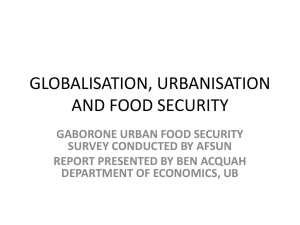Application of the IEC 62232 standard to EMF measurements around cellular base stations
advertisement
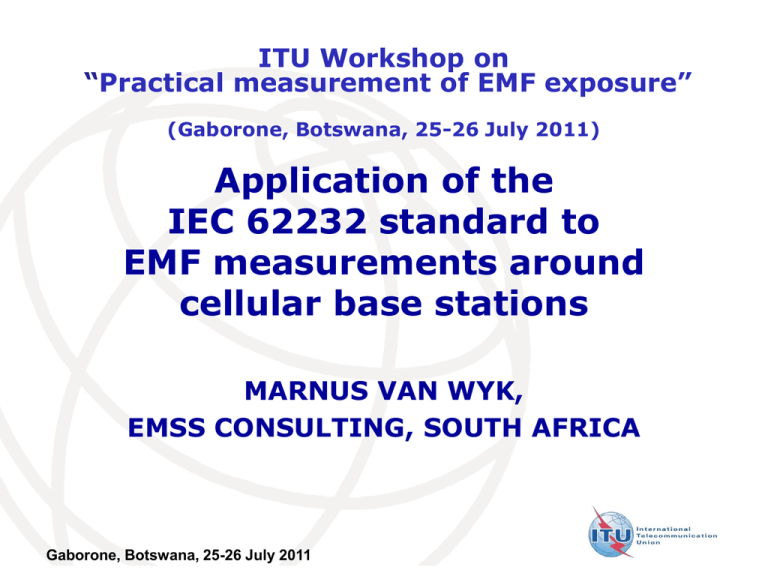
ITU Workshop on “Practical measurement of EMF exposure” (Gaborone, Botswana, 25-26 July 2011) Application of the IEC 62232 standard to EMF measurements around cellular base stations MARNUS VAN WYK, EMSS CONSULTING, SOUTH AFRICA Gaborone, Botswana, 25-26 July 2011 Content Why EMF Measurements? EMSS Overview RF fields in our environment Guidelines for safe exposure Typical exposure vs guidelines Cellular Networks Gaborone, Botswana, 25-26 July 2011 2 Content Measurement Equipment Measurement Methodology Demo Reporting Uncertainty analysis Exclusions Gaborone, Botswana, 25-26 July 2011 3 Content Base station Compliance Conclusion Gaborone, Botswana, 25-26 July 2011 4 Content Why EMF Measurements? EMSS Overview RF fields in our environment Guidelines for safe exposure Typical exposure vs guidelines Cellular Networks Gaborone, Botswana, 25-26 July 2011 5 Why EMF Measurements? Cellular exclusion zone accessibility Measurements normally not required or used to determine compliance boundary Measure at publicly accessible areas around cellular base stations Public concern Gaborone, Botswana, 25-26 July 2011 6 Why EMF Measurements? Example site: Photographs Gaborone, Botswana, 25-26 July 2011 7 Why EMF Measurements? Example site: Map Gaborone, Botswana, 25-26 July 2011 8 Why EMF Measurements? Example site: Report Gaborone, Botswana, 25-26 July 2011 9 Why EMF Measurements? Example site: Report Gaborone, Botswana, 25-26 July 2011 10 Why EMF Measurements? Determine compliance boundary Radar, TV, etc installations Not covered in this talk Gaborone, Botswana, 25-26 July 2011 11 Content Why EMF Measurements? EMSS Overview RF fields in our environment Guidelines for safe exposure Typical exposure vs guidelines Cellular Networks Gaborone, Botswana, 25-26 July 2011 12 EMSS Overview Based in Stellenbosch, South Africa Focus on electromagnetics Non EMF safety activities FEKO Radio Astronomy Karoo Array Telescope Gaborone, Botswana, 25-26 July 2011 13 EMSS Overview Products and services in the field of EMF Safety Ixus – Compliance Software fieldSENSE Site assessment and certification RF awareness training EMF Measurements Gaborone, Botswana, 25-26 July 2011 14 Content Why EMF Measurements? EMSS Overview RF fields in our environment Guidelines for safe exposure Typical exposure vs guidelines Cellular Networks Gaborone, Botswana, 25-26 July 2011 15 Radio Frequency Fields in Our Environment Radio TV RF Sources? Base Stations Microwave Ovens WiFi Comms in Vehicles Cellphones Gaborone, Botswana, 25-26 July 2011 16 Radio Frequency Fields in Our Environment AM radio 1 10 100 100 Hz 1 10 100 1 kHz Mobile Phones FM radio Satellite TV 10 100 MHz 1 10 GHz Radio frequency radiation Non-ionising radiation Gaborone, Botswana, 25-26 July 2011 Lasers 100 1 10 X rays Gamma rays THz Ionising radiation Ionising radiation 17 Radio Frequency Fields in Our Environment RF Exposure Base Station Radio Frequency Fields in Our Environment Cellular communications Content Why EMF Measurements? EMSS Overview RF fields in our environment Guidelines for safe exposure Typical exposure vs guidelines Cellular Networks Gaborone, Botswana, 25-26 July 2011 20 Guidelines for Safe Exposure De facto standard for RF safety Endorsed by World Health Organization (WHO) and numerous other international health bodies Thousands of Research Studies (since 1950s) Intense periods of research: 1970s (Microwave Oven), 1990s (Mobiles) Gaborone, Botswana, 25-26 July 2011 21 Guidelines for Safe Exposure Basic restrictions – Protect against heating (Known health effect) Two Tiers Occupational, Safety factor of 10, RF trained, medically screened General public, Safety factor of 50 4 3.5 SAR [W/kg] 3 2.5 2 1.5 1 0.5 Gaborone, Botswana, 25-26 July 2011 0 Excessive Heating Occupational Limit General Public Limit 22 Guidelines for Safe Exposure At mobile frequencies: Basic restrictions (W/kg) not easily measured in field Gaborone, Botswana, 25-26 July 2011 23 Guidelines for Safe Exposure At mobile frequencies: Thus “reference levels” (V/m or W/m2) derived from basic restrictions Measurements in terms of the “reference levels” Gaborone, Botswana, 25-26 July 2011 24 Content Why EMF Measurements? EMSS Overview RF fields in our environment Guidelines for safe exposure Typical exposure vs guidelines Cellular Networks Gaborone, Botswana, 25-26 July 2011 25 Typical Exposure vs Guidelines Logarithmic scale of “typical” values 100 10 1 0.1 0.01 0.001 0.0001 TV and Radio Base Station Gaborone, Botswana, 25-26 July 2011 Cordless Phone Microwave Oven Cellphone ICNIRP Health Effect 26 Typical Exposure vs Guidelines More than 77 000 measurements Gaborone, Botswana, 25-26 July 2011 27 Content Why EMF Measurements? EMSS Overview RF fields in our environment Guidelines for safe exposure Typical exposure vs guidelines Cellular Networks Gaborone, Botswana, 25-26 July 2011 28 Cellular networks First mobile? Analog wireless phone took of in 70s GSM early 90s 1924 Gaborone, Botswana, 25-26 July 2011 29 Cellular networks Maximum of 60W per polarization on GSM900 on each antenna Typical transmit power levels 100000 10000 1000 100 10 1 0.1 0.01 Cordless Phone Base Station Cellphone Communication antenna on a ship Microwave Oven Radar TV/Radio Gaborone, Botswana, 25-26 July 2011 30 Cellular networks “Low” power transmitters (60W) Short distances between base station sites 2 way communication with 2W cellphones Avoid interference Use relatively low power Gaborone, Botswana, 25-26 July 2011 31 Cellular networks Compared to TV / Radio high power transmitters (50kW) One site, one way communication Gaborone, Botswana, 25-26 July 2011 32 Cellular networks Evolution First generation (1G) – Analog Second generation (2G) – Digital Third generation (3G) – Digital & additional data services eg video calling LTE… Gaborone, Botswana, 25-26 July 2011 33 Cellular networks First generation (1G) Analog Separate Frequencies FDMA — Frequency Division Multiple Access 30 KHz Frequency 30 KHz 30 KHz 30 KHz 30 KHz 30 KHz 30 KHz 30 KHz Gaborone, Botswana, 25-26 July 2011 34 Cellular networks Second generation (2G) Digital Time Division Multiple Access BCCH channel (Broadcast & Control) One timeslot = 0.577 ms One TDMA frame = 8 timeslots Frequency 200 KHz 200 KHz 200 KHz 200 KHz Gaborone, Botswana, 25-26 July 2011 Time 35 Cellular networks Adaptive Power Control 2G site call capacity Each Transceiver 8 timeslots Assume each sector 4 transceivers 8*4 timeslots; at least 1 for BCCH =>32-1 calls Site has 3 sectors =>31 * 3 calls Gaborone, Botswana, 25-26 July 2011 36 Cellular networks Third generation (3G) Digital & additional data services eg video calling Code Division Multiple Access Gaborone, Botswana, 25-26 July 2011 37 Cellular networks Sources www.nmscommunications.com www.attws.com www.wikipedia.org Gaborone, Botswana, 25-26 July 2011 38 Content Measurement Equipment Measurement Methodology Demo Reporting Uncertainty analysis Exclusions Gaborone, Botswana, 25-26 July 2011 39 Measurement Equipment Two types of measurement devices Broadband meters Cannot differentiate between different sources Frequency selective Spectrum analyser Differentiate different sources Choose spectrum analyser Gaborone, Botswana, 25-26 July 2011 40 Measurement Equipment Spectrum analyser Differentiate different sources Generally better for low signal levels Gaborone, Botswana, 25-26 July 2011 41 Measurement Equipment Isotropic probe (antenna) – Not directional Gaborone, Botswana, 25-26 July 2011 42 Measurement Equipment Mostly use 27 (75) MHz to 3GHz Mobile probe Phones FM radio AM radio Satellite Lasers TV 1 10 100 100 Hz 1 10 kHz 100 1 10 MHz Gaborone, Botswana, 25-26 July 2011 100 1 10 GHz 100 1 10 X rays Gamma rays THz 43 Measurement Equipment Want to allocate service or operators to spectrum parts FM GSM900 DCS1800 Gaborone, Botswana, 25-26 July 2011 Gaborone, Botswana, 25-26 July 2011 44 Measurement Equipment Straight forward, since spectrum analyser differentiates between different sources Integrate spectrum results to give exposure per service/operator Gaborone, Botswana, 25-26 July 2011 45 Measurement Equipment BTA Spectrum allocation used Lower Frequency 27 MHz 88 MHz 108 MHz 117.975 MHz 138.00 MHz 146.00 MHz 380.00 MHz 410.4 MHz 880 MHz 935.2 MHz 943.2 MHz 951.4 MHz 1.71 GHz 1.8052 GHz 1.8154 GHz 1.8258 GHz 1.92 GHz 2.125 GHz 2.14 GHz 2.155 GHz 2 995MHz Gaborone, Botswana, 25-26 July 2011 Upper Frequency 88MHz 108 MHz 117.975 MHz 136.00 MHz 143.7 MHz 174.00 MHz 395.00 MHz 424.9 MHz 915 MHz 943.2 MHz 951.4 MHz 955.6 MHz 1.785 GHz 1.8154 GHz 1.8258 GHz 1.8298 GHz 1.98 GHz 2.14 GHz 2.155 GHz 2.17 GHz 3 000MHz Name Below FM FM Radio Aeronautical Radionavagation Aeronautical Mobile (R) Alarms Land Mobile TETRA Public Trucking GSM900UL GSM900DL Mascom GSM900DL Orange GSM900DL BTC DCS1800 UL DCS1800DLMascom DCS1800DLOrange DCS1800 DL BTC UMTS UL UMTSDL Orange UMTSDL BTC UMTSDL Mascom 3GHz Band 46 Measurement Equipment Various devices available Gaborone, Botswana, 25-26 July 2011 47 Measurement Equipment Narda SRM3000 – old model Narda SRM3006 – built in GPS Calibration frequency: 2 years Expanded measurement uncertainty: 3.7dB Gaborone, Botswana, 25-26 July 2011 48 Measurement Equipment Equipment demo Spectrum measurement GSM power control W-CDMA demodulation 2157.4MHz Tabled results - Safety table Gaborone, Botswana, 25-26 July 2011 49 Content Measurement Equipment Measurement Methodology Demo Reporting Uncertainty analysis Exclusions Gaborone, Botswana, 25-26 July 2011 50 Measurement Methodology Choosing measurement positions Publicly accessible positions Points of local maximum exposure Points of specific interest Typically 6-10 points per site Gaborone, Botswana, 25-26 July 2011 51 Measurement Methodology Sectorized site example P8 Houses Houses P2 P3 P1 Houses P4 P5 Playground Entrance Shopping Centre P7 P6 Creche Gaborone, Botswana, 25-26 July 2011 52 Measurement Methodology Choosing measurement positions Publicly accessible positions Normally well outside exclusion zones Gaborone, Botswana, 25-26 July 2011 53 Measurement Methodology Choosing measurement positions Points of local maximum exposure In sector lines, where mainlobe hits the Power Density vs Distance ground z=0.2m z=0.4m z=0.6m z=0.8m z=1.0m z=1.2m z=1.4m z=1.6m z=1.8m z=2.0m 0.45 0.4 Slope up S [W/m^2] 0.35 0.3 0.25 0.2 0.15 0.1 0.05 0 0 20 40 60 80 100 120 140 160 180 200 Distance along Line A [meter]: z=0m Gaborone, Botswana, 25-2 July 2011 54 Measurement Methodology Choosing measurement positions Typically 6-10 points per site 1 Position at site location Sector line positions Positions of specific interest Gaborone, Botswana, 25-26 July 2011 55 Measurement Methodology Example positions Gaborone, Botswana, 25-26 July 2011 56 Measurement Methodology Example positions Gaborone, Botswana, 25-26 July 2011 57 Measurement Methodology Example positions Gaborone, Botswana, 25-26 July 2011 58 Measurement Methodology Example positions Gaborone, Botswana, 25-26 July 2011 59 Measurement Methodology Example positions Gaborone, Botswana, 25-26 July 2011 60 Measurement Methodology IEC 62232 Evaluation purpose RF field strength for interested parties at arbitrary locations outside control boundary RBS category Simple or complex (multiple antenna & operator) RBS Gaborone, Botswana, 25-26 July 2011 61 Measurement Methodology Information availability Spectrum licensing info available, etc Parameter control RBS not controlled (BCCH and traffic) Ambient sources Visual inspection Spectrum measurement Gaborone, Botswana, 25-26 July 2011 62 Measurement Methodology Source-Environment plane Source region III (Far field) Environment region 0,1,M due to possible reflections Gaborone, Botswana, 25-26 July 2011 63 Measurement Methodology Evaluation method E-Field (V/m) or Power Density (W/m2) Gaborone, Botswana, 25-26 July 2011 64 Measurement Methodology In situ measurements used Client requirements / physical demonstration for interested persons Publicly accessible areas chosen for evaluation locations Use handheld instrument at 1.5m Sweep area, searching maximum Spatial averaging not used Frequency selective measurement (not broadband flat or shaped) Gaborone, Botswana, 25-26 July 2011 65 Measurement Methodology Evaluate in terms of limit Extrapolation might be required Extrapolate from BCCH / CPICH for maximum transmission possible Reporting Uncertainty assessment Gaborone, Botswana, 25-26 July 2011 66 Content Measurement Equipment Measurement Methodology Demo Reporting Uncertainty analysis Exclusions Gaborone, Botswana, 25-26 July 2011 67 Demo Gaborone, Botswana, 25-26 July 2011 68 Content Measurement Equipment Measurement Methodology Demo Reporting Uncertainty analysis Exclusions Gaborone, Botswana, 25-26 July 2011 69 Reporting Procedure automated in Ixus Improve accuracy & efficiency Data stored on central database Gaborone, Botswana, 25-26 July 2011 70 Reporting Procedure Pre-processing Measurement Gaborone, Botswana, 25-26 July 2011 71 Reporting Procedure Post-processing Front page photo Map Position comments PDF report 72 Gaborone, Botswana, 25-26 July 2011 Reporting Gaborone, Botswana, 25-26 July 2011 73 Reporting Gaborone, Botswana, 25-26 July 2011 74 Reporting Gaborone, Botswana, 25-26 July 2011 75 Reporting Gaborone, Botswana, 25-26 July 2011 76 Reporting Gaborone, Botswana, 25-26 July 2011 77 Content Measurement Equipment Measurement Methodology Demo Reporting Uncertainty analysis Exclusions Gaborone, Botswana, 25-26 July 2011 78 Uncertainty analysis Important to assess the uncertainty, when interpreting results 79 Gaborone, Botswana, 25-26 July 2011 Uncertainty analysis 80 Gaborone, Botswana, 25-26 July 2011 Uncertainty analysis 81 Gaborone, Botswana, 25-26 July 2011 Content Measurement Equipment Measurement Methodology Demo Reporting Uncertainty analysis Exclusions Gaborone, Botswana, 25-26 July 2011 82 Exclusions Determine compliance boundary Extrapolation for maximum Region I (Reactive near-field) Gaborone, Botswana, 25-26 July 2011 83 Exclusions Radar installations Time on Target -> Peak or RMS relevant Probe displayed value needs correction, based on radar PRF, Duty cycle Gaborone, Botswana, 25-26 July 2011 84 Content Base station Compliance Conclusion Gaborone, Botswana, 25-26 July 2011 85 Base station Compliance Assess accessibility of EMF Exclusion zones Generic rules 86 Gaborone, Botswana, 25-26 July 2011 Base station Compliance Assess accessibility of EMF Exclusion zones Numerical simulation 87 Gaborone, Botswana, 25-26 July 2011 Base station Compliance Assess accessibility of EMF Exclusion zones Measurements 88 Gaborone, Botswana, 25-26 July 2011 Base station Compliance Administrative controls Access control RF warning signage 89 Gaborone, Botswana, 25-26 July 2011 Base station Compliance Administrative controls Access control RF warning signage 90 Gaborone, Botswana, 25-26 July 2011 Base station Compliance Use Ixus to manage network compliance ICNIRP Compliance Identify RF Hazard Zones at Sites Monitor Controls and Document Process Controls to Avoid Over-Exposure Access Control, Signage, Painted Lines RF Awareness Training EMF Site Access Procedures 91 Gaborone, Botswana, 25-26 July 2011 Content Base station Compliance Conclusion Gaborone, Botswana, 25-26 July 2011 92 Conclusion Gaborone, Botswana, 25-26 July 2011 93 Thank you Questions? mvanwyk@emss.co.za
